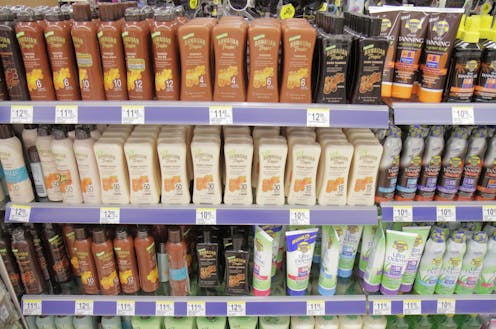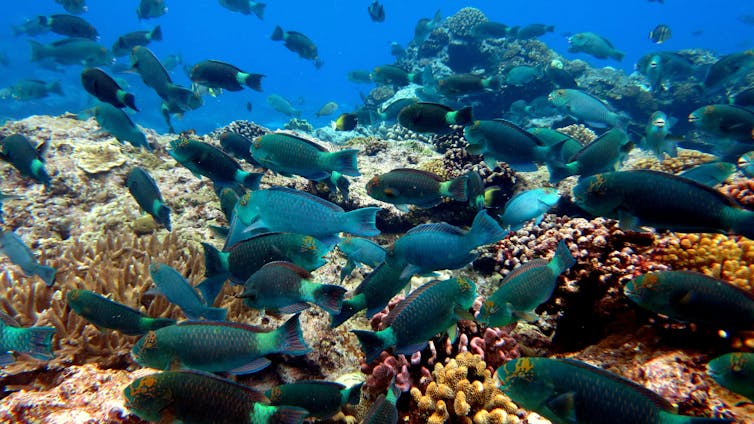Do chemicals in sunscreens threaten aquatic life? A new report says a thorough assessment is 'urgent
Rising concern about possible environmental damage from the active ingredients in sunscreens could have ripple effects on public health if it causes people to use less of them.

Studies have shown that the same active ingredients in sunscreens that protect people from cancer-causing ultraviolet rays can be toxic to a range of species in oceans, rivers and lakes. With both of these risks in mind, a new report from the National Academies of Sciences, Engineering and Medicine finds an urgent need for more information about whether these chemicals threaten aquatic life on a broad scale.
The report calls on the U.S. Environmental Protection Agency to conduct a detailed review called an environmental risk assessment of the likelihood that exposure to one or more of these chemicals, called UV filters, may harm organisms in saltwater and freshwater ecosystems. The study recommends focusing on two types of settings – coral reefs in shallow waters near shore, and slow-moving freshwater bodies like ponds and marshes – that are heavily used for recreation and/or exposed to wastewater or urban runoff.
The study recognizes that sunscreen with a Sun Protection Factor (SPF) of 30 or higher is an effective defense against sunburn and skin cancer, and that making it harder to buy broad-spectrum sunscreen that people will actually use could harm public health. Accordingly, it calls for research examining how changes in sunscreen usage could affect human health. Two members of the study committee explain how their group balanced these concerns.
Many species are exposed to many stresses
Robert Richmond, Research Professor and Director, Kewalo Marine Laboratory, University of Hawaii at Manoa
Studies to date have provided compelling laboratory evidence that some UV filters can have toxic effects on aquatic species, including corals, anemones and zebrafish, that are exposed to the chemicals. These findings have raised concerns about sunscreens’ larger-scale impacts on biological communities and ecosystems.
But outcomes in the environment will differ depending on what compounds, ecosystems and local environmental conditions are involved. That’s especially true for coral reefs. The committee highlighted reefs because they are ecologically, economically and culturally valuable, and attract large numbers of tourists who use sunscreens.
Coral reefs are declining worldwide due to multiple human-induced disturbances. Some of these disturbances are global, such as ocean warming and acidification driven by climate change. Other stressors, such as coastal water quality, are more local.
Studying the effects of chemicals on corals and coral reefs is challenging because they are both complex systems. Reef-building corals are a combination of an animal, single-celled algae and rich populations of bacteria living and working together. Coral reefs are made up of thousands of interacting organisms.
Importantly, many stress responses in corals occur without causing outright death, but impair their health, growth, resilience and even ability to reproduce. Scientists need to know more about these responses to guide effective management responses and interventions.

After in-depth reviews of the existing data, our study committee recommended that the U.S. Environmental Protection Agency should undertake an ecological risk assessment of the 17 UV filters used in sunscreens sold in the U.S. Such a study would include a comparison of toxicity findings to relevant concentrations and exposure conditions.
For example, what happens to organisms exposed to these chemicals occasionally versus those exposed regularly, in calm bays or along open, wave-swept coasts? How do UV filters differ in whether they break down in water, or accumulate in sediments or the tissues of living organisms?
In our view, an ecological risk assessment would provide EPA and others the basis for sound and effective policy development. The sooner this happens and the results are applied to the regulatory process, the better for everyone who is affected, including future generations.
Lab results versus real-world conditions
Karen Glanz, George A. Weiss University Professor and Director, UPenn Prevention Research Center, University of Pennsylvania
The question of whether UV filters pose harm to the environment while helping to reduce skin damage and prevent skin cancer is a conundrum. It seemingly pits human and environmental health against each other head-to-head and asks policymakers, medical experts and the public to choose between them.
Humans need sunlight to live, but overexposure to the sun’s damaging rays – ultraviolet radiation – causes sunburn and wrinkles and is a risk factor for the development of skin cancers, including the most deadly type, melanoma. Routine use of broad-spectrum sunscreen with SPF 30+ when outdoors has been found to prevent skin damage and skin cancer. But sunscreens are most effective as part of a set of behaviors that also includes wearing hats and cover-up clothing and seeking shade.
Most people in the U.S. don’t practice these behaviors frequently or thoroughly enough. So it’s important to weigh very carefully the potential effects of restricting the choice of available sunscreens.
Some jurisdictions already restrict the sale of certain sunscreens because concerned advocates believe doing so will be good for the environment. In the U.S., they include Hawaii, the U.S Virgin Islands and the city of Key West, Florida. Our report doesn’t draw a definitive conclusion about whether these measures are scientifically justified or effective. Rather, it emphasizes analyzing whether and how they may affect human health as well as the environment.
The study draws attention to the challenge of understanding risks from UV filters to aquatic environments under various conditions, and in the context of overarching environmental stressors such as rising sea temperatures. It’s important to understand that for both environmental and human health issues, laboratory studies don’t always match what happens in the environment.
Studies of model systems such as bacteria and yeast, and organisms such as fish embryos and insect larvae, can yield findings that do not hold up in studies of humans. For both the environment and humans, it may not be possible or ethical to conduct true experiments that test the long-term effects of chemicals in UV filters.
Members of our committee wrestled to interpret the available evidence, and also with the gaps in that evidence. Ultimately we concluded that the science is not settled, but that there is much to build on to advance understanding of this issue. Our conclusions are not a win/lose outcome for either the environment or humans. Rather, they point to a need to think both broadly and strategically for the benefit of people and the planet.
Robert Richmond receives funding from the National Science Foundation, the National Oceanic and Atmospheric Administration, the U.S. Fish and Wildlife Service, the Pew Environmental Group, the National Fish and Wildlife Foundation, the H.W. Hoover Foundation and the Hawaii Division of Aquatic Resources. He has been a Pew Fellow in Marine Conservation, and an Aldo Leopold Fellow in Environmental Leadership, and has served on the Board of Directors of the Palau International Coral Reef Center and as Science Advisor to the All Islands Committee of the US Coral Reef Task Force. He was a member of a previous study committee organized by the National Academies, on Interventions to Increase the Resilience of Coral Reefs.
Karen Glanz conducts research cancer prevention and control, theories of health behavior, and social and health policy. She has conducted descriptive, observational, methodological, intervention, and dissemination research in skin cancer prevention since 1993. She has worked on analyses of national surveys of UV exposure and sun protection; developed, analyzed and validated measures and methods of skin cancer prevention research; and led evidence reviews for skin cancer prevention. Her research has been funded by the U.S. Centers for Disease Control and Prevention, the National Institutes of Health, and the Skin Cancer Foundation. Dr. Glanz served on the US Task Force on Community Preventive Services for 10 years and co-led reviews of the effectiveness of skin cancer prevention programs. She is an elected member of the National Academy of Medicine.
Read These Next
RFK Jr. wants to scrutinize the vaccine schedule – but its safety record is already decades long
Federal officials are questioning the safety of the vaccine series children receive. Here’s the story…
Miami’s new mayor faces a housing affordability crisis, city charter reform and a shrinking budget
Eileen Higgins won a hard-fought election to become Miami’s new mayor. Now for the hard part – governing…
Understanding climate change in America: Skepticism, dogmatism and personal experience
Real skeptics study the evidence and ask questions, rather than taking political dogma on faith. Experiencing…






